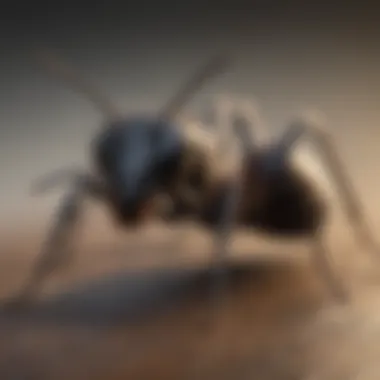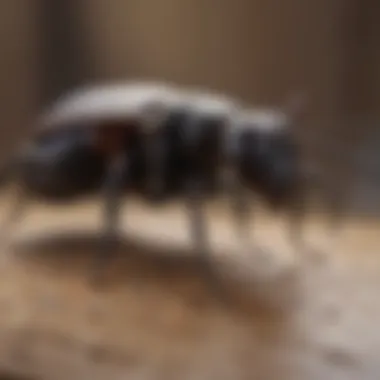Ultimate Guide to Carpenter Ant Control Kits: Mastering Infestation Combat


Preventive Pest Control Strategies
When it comes to safeguarding your home against carpenter ants and other pests, implementing preventive pest control strategies is key. Starting with protecting the house exterior, it is imperative to seal any cracks or gaps that could serve as entry points for pests. Clearing debris in and around your home not only enhances its aesthetics but also minimizes hiding spots for unwanted critters. Moreover, taking proactive measures to prevent pests from entering your living space adds an extra layer of defense.
In addition to focusing on the exterior, maintaining your yard plays a crucial role in pest prevention. Establishing essential yard care routines such as regular mowing, pruning, and adequate watering can significantly reduce the likelihood of a pest infestation. Furthermore, employing methods like keeping vegetation trimmed and implementing natural pest deterrents helps in keeping your yard pest-free.
Indoor cleanliness is another critical aspect of pest control. By adhering to expert cleaning tips and techniques, you can create an environment that is less attractive to pests. This includes tasks such as proper food storage, maintaining cleanliness in high-risk areas like kitchens and bathrooms, and promptly addressing any water leaks to prevent water damage that could attract pests.
Proper garbage disposal is often an overlooked yet essential component of pest control. Implementing efficient waste disposal methods, such as sealing garbage bins tightly and using trash bags with sealable closures, can go a long way in deterring pests from lingering around your home. Understanding the importance of promptly disposing of trash and maintaining a cleanliness routine in this regard is paramount.
In addition to these fundamental preventative measures, exploring innovative ways to safeguard your home against pests can further fortify your defense. Whether it involves utilizing advanced technologies like ultrasonic pest repellents or integrating smart home solutions for pest monitoring, embracing these strategies can enhance your overall pest control efforts.
Understanding Carpenter Ants
Understanding carpenter ants is crucial in effectively managing and preventing infestations. These destructive pests can cause significant structural damage to properties, making it essential to comprehend their behavior and habits. By gaining insights into carpenter ant characteristics, a homeowner can proactively address and mitigate potential issues.
Carpenter Ant Characteristics
Physical Description
Carpenter ants are generally large ants, ranging in size from ¼ to ½ inch. They are often black in color, although some species can exhibit shades of red or yellow. Their distinguishing feature is the evenly rounded thorax when viewed from the side. This physical characteristic helps differentiate them from other ant species and aids in identification during infestations.
Nesting Habits
Unlike termites that feed on wood, carpenter ants do not consume wood for sustenance. Instead, they excavate galleries within wood to create their nests. These galleries are smooth and clean, with a distinct appearance from termite-damaged wood. Carpenter ants prefer moist or decaying wood for nesting, making areas with water damage prime locations for infestations.
Dietary Preferences


While carpenter ants primarily feed on insects and plant exudates, they also seek out sugary substances in homes. Their foraging habits can lead them to indoor food sources, causing nuisance infestations within residential spaces. Understanding their dietary preferences can help homeowners implement bait strategies effectively to attract and eliminate these pests.
Signs of Carpenter Ant Infestation
Recognizing the signs of a carpenter ant infestation is vital for prompt intervention. By being aware of key indicators, homeowners can address infestations before significant damage occurs.
Wood Damage
Carpenter ants excavate wood to build their galleries, resulting in smooth tunnels with a polished appearance. Unlike termites that consume wood cellulose, carpenter ants only remove wood to create nesting space, leaving behind shavings and debris near entry points.
Sawdust Trails
One common sign of a carpenter ant infestation is the presence of sawdust trails near nesting sites. These trails consist of tiny wood particles and ant body parts discarded by the ants during excavation. Observing these sawdust trails can help pinpoint active infestation areas within a property.
Rustling Sounds
Carpenter ants produce rustling sounds within their nest sites by moving and shifting materials during excavation. Homeowners may detect faint noises emanating from walls or structural voids affected by carpenter ant activity. Being attuned to these unique sounds can aid in early detection and targeted control measures.
Components of Carpenter Ant Control Kits
In the realm of carpenter ant control, the significance of having a well-equipped arsenal cannot be overstated. Carpenter Ant Control Kits play a crucial role in effectively combating carpenter ant infestations by providing a comprehensive approach to pest management. These kits typically consist of various elements that work together harmoniously to address different aspects of carpenter ant eradication and prevention. By including a range of essential tools such as baits, traps, insecticides, and protective gear, these kits offer a holistic solution to tackle carpenter ant issues effectively. When considering Carpenter Ant Control Kits, it is vital to assess the specific components included, their benefits, and how they contribute to the overall goal of managing and preventing carpenter ant infestations. Ensuring that each component is chosen thoughtfully and strategically can significantly enhance the success of the control efforts.
Baits and Traps
Gel Baits
Gel baits are a fundamental component of Carpenter Ant Control Kits, known for their efficacy in attracting and eliminating carpenter ant colonies. Their key characteristic lies in their attractant properties, drawing carpenter ants towards the bait for consumption. This targeted approach makes gel baits a popular choice for effectively controlling ant populations. One unique feature of gel baits is their long-lasting effect, ensuring continuous control even after application. However, a potential disadvantage is that gel baits may require reapplication in case of heavy infestations or adverse weather conditions, making regular monitoring essential for optimal results.
Granular Baits


Granular baits represent another vital element in Carpenter Ant Control Kits, offering a convenient option for bait application in various settings. The key characteristic of granular baits lies in their ease of use and ability to cover larger areas efficiently. This makes them a beneficial choice for managing carpenter ant infestations in outdoor spaces or expansive indoor environments. One unique feature of granular baits is their weather-resistant nature, ensuring sustained effectiveness under different conditions. However, it's important to note that granular baits may require reapplication after heavy rainfall or soil disruption, requiring careful monitoring for consistent control.
Ant Traps
Ant traps serve as a strategic tool in Carpenter Ant Control Kits, providing a targeted approach to trap and eliminate carpenter ants. Their key characteristic is the use of bait stations that lure ants inside, where they are captured and prevented from returning to the colony. This methodical approach makes ant traps a valuable choice for containing ant populations within defined areas. A unique feature of ant traps is their non-toxic nature, making them safe for use in various environments, including residential spaces. However, it's important to regularly inspect and replace ant traps to ensure continued efficacy and prevent re-infestation, highlighting the need for ongoing monitoring in carpenter ant control efforts.
Using Carpenter Ant Control Kits Effectively
Carpenter ant control is a serious matter that requires careful consideration and effective implementation. In this article, the focus is on the crucial aspect of using carpenter ant control kits efficiently. By understanding how to utilize these kits effectively, individuals can take proactive measures to manage and prevent carpenter ant infestations. Discussing specific elements such as inspection techniques, damage assessment, strategic placement, regular monitoring, sealing entry points, and removal of moisture sources will provide detailed guidance on maximizing the efficacy of carpenter ant control kits.
Identifying Infestation Extent
Inspection Techniques
Inspection techniques play a pivotal role in determining the extent of carpenter ant infestations. By utilizing comprehensive methods such as visual surveys, tapping, and listening for activity, individuals can accurately assess the severity of the problem within a structure. The key characteristic of inspection techniques lies in their ability to pinpoint nest locations and track ant movements, aiding in targeted control measures. The unique feature of inspection techniques is their non-invasive nature, allowing for thorough assessment without causing additional damage. While inspection techniques are beneficial for accurate infestation identification, they may require time and attention to detail, contributing to successful carpenter ant control efforts.
Damage Assessment
Damage assessment serves as a vital component in understanding the impact of carpenter ant infestations on structures. By examining wood surfaces for tunneling marks, frass deposits, or weakened structural integrity, individuals can gauge the extent of damage inflicted by these pests. The key characteristic of damage assessment is its ability to provide visual evidence of infestation severity, aiding in decision-making for control strategies. The unique feature of damage assessment is its tangible representation of ant activities, facilitating targeted treatment applications. While damage assessment is crucial for evaluating structural harm, it may require professional expertise to interpret complex signs accurately, ensuring thorough control measures.
Application of Control Measures
Strategic Placement
Strategic placement of bait stations and insecticide-treated areas is essential for successful carpenter ant control. By identifying high-traffic zones and entry points, individuals can strategically deploy control products to intercept ant foraging paths effectively. The key characteristic of strategic placement is its tailored approach to targeting ant colonies at their source, disrupting nesting behavior and reducing population growth. The unique feature of strategic placement is its ability to create barriers that prevent ant access to vulnerable areas, leading to enhanced control efficacy. While strategic placement requires precise positioning and ongoing adjustment, it offers strategic advantages in long-term infestation management.
Regular Monitoring


Regular monitoring of bait station and trap activity is crucial for evaluating the effectiveness of control measures over time. By routinely checking for ant encounters, feeding patterns, and population changes, individuals can gauge the impact of intervention strategies and make informed adjustments. The key characteristic of regular monitoring is its proactive approach to tracking ant behavior, allowing for timely response to emerging infestation dynamics. The unique feature of regular monitoring is its data-driven insights that enable continual optimization of control tactics, enhancing long-term control outcomes. While regular monitoring demands consistent observation and data recording, it empowers individuals with valuable information for adaptive control strategies.
Preventive Strategies
Sealing Entry Points
Sealing entry points in structures is a fundamental preventive strategy against carpenter ant invasions. By identifying and sealing cracks, gaps, and openings that serve as entryways for ants, individuals can fortify the building's defenses against incursions. The key characteristic of sealing entry points is its direct prevention of ant infiltration, eliminating potential nesting sites and foraging routes. The unique feature of sealing entry points is its sustainable barrier to indoor ant intrusion, reducing the likelihood of infestation recurrence. While sealing entry points requires meticulous attention to detail and thorough coverage, it offers lasting protection against carpenter ant ingress.
Removal of Moisture Sources
Removing moisture sources within and around structures is key to deterring carpenter ants attracted to damp environments. By addressing leaks, condensation, and standing water issues, individuals can create an unfavorable habitat for ants seeking moisture. The key characteristic of moisture source removal is its disruption of ant-attracting conditions, minimizing the appeal of a given area for infestation. The unique feature of moisture source removal is its proactive stance against conducive ant environments, enhancing the overall effectiveness of control measures. While moisture source removal demands consistent maintenance and vigilance, it serves as a holistic approach to preventing carpenter ant colonization and proliferation.
Choosing the Right Carpenter Ant Control Kit
When it comes to combating carpenter ant infestations effectively, selecting the right control kit is paramount. The choice of control kit can make a significant difference in the success of managing and preventing carpenter ant issues. By carefully assessing and selecting a control kit tailored to the specific needs of your infestation, you can increase the efficiency and effectiveness of your eradication efforts.
Assessing Infestation Severity
Small-Scale Infestations
Small-scale infestations play a crucial role in the overall strategy of carpenter ant control. These infestations are characterized by a limited presence of ants within a confined area. Opting for control kits designed for small-scale infestations is beneficial as they come in smaller sizes and often contain targeted solutions suitable for localized ant populations. The key advantage of addressing small-scale infestations lies in the precise application of control measures, minimizing wastage and environmental impact. While small-scale infestations may seem manageable on the surface, they can quickly escalate if not addressed promptly.
Large-Scale Infestations
On the other end of the spectrum are large-scale infestations, which present a more widespread and challenging scenario. Large-scale infestations involve multiple ant colonies or extensive areas of infestation within a structure. Choosing control kits specifically designed for large-scale infestations is crucial due to their capacity and coverage. These kits contain more significant quantities of control products and are formulated to tackle extensive ant populations effectively. Dealing with large-scale infestations demands a comprehensive approach that targets not only visible ants but also hidden colonies and satellite nests. While the complexity of large-scale infestations requires strategic planning and persistent treatment, selecting the appropriate control kit can streamline the eradication process.
Environmental Considerations
Indoor Application
Indoor application of carpenter ant control kits is essential for addressing infestations within the confines of a structure. Indoor formulations are designed to target ants dwelling inside walls, attics, and other internal spaces where infestations thrive. The key characteristic of indoor application products is their ability to adhere to surfaces and reach inaccessible areas where ants may be nesting. This targeted approach minimizes exposure to humans and pets while maximizing the impact on ant populations. However, indoor applications require caution to prevent contamination of living spaces and ensure the safety of occupants.
Outdoor Application
Outdoor application of control kits is vital for preventing carpenter ants from infiltrating structures and controlling external populations. Outdoor formulations are formulated to withstand environmental conditions and provide long-lasting protection against foraging ants. The key advantage of outdoor application lies in creating a barrier that repels ants and limits their access to indoor spaces. By deploying control measures around the perimeter of a structure, you can deter ants from establishing trails and entering buildings. Outdoor applications are pivotal in creating a zone of protection that reduces the risk of reinfestation and complements indoor treatment strategies.



